Can you sleep with earbuds? Yes, you can sleep with earbuds or headphones, but it's not without risks.
The night whispers with possibilities, especially when it’s about drifting into dreamland with your favorite tunes or the calming sound of white noise.
Sleeping with earbuds has become more than a trend in today’s bustling world. It’s a lifestyle choice for many.
Whether it’s to escape the snoring symphony from your partner or to find solace in the soothing sounds of nature, earbuds serve as a personal escape to tranquility.
But why has this practice become so popular? It’s simple. Life doesn’t quiet down because we’re ready to hit the pillow.
Finding peace can be challenging, from noisy neighbors to the endless hum of city life. Earbuds offer a solution to create your soundscape that whispers, “It’s time to rest.”
“Sleeping with earbuds,” a phrase that might have seemed foreign a decade ago, is now a nightly ritual for many. It’s a topic rich with nuances, from sounds that whisk us away to dreamland to the gadgets that make it possible.
As we dive into this guide, we’ll explore the harmonious blend of technology and well-being, ensuring your journey to the land of Nod is both safe and sound.
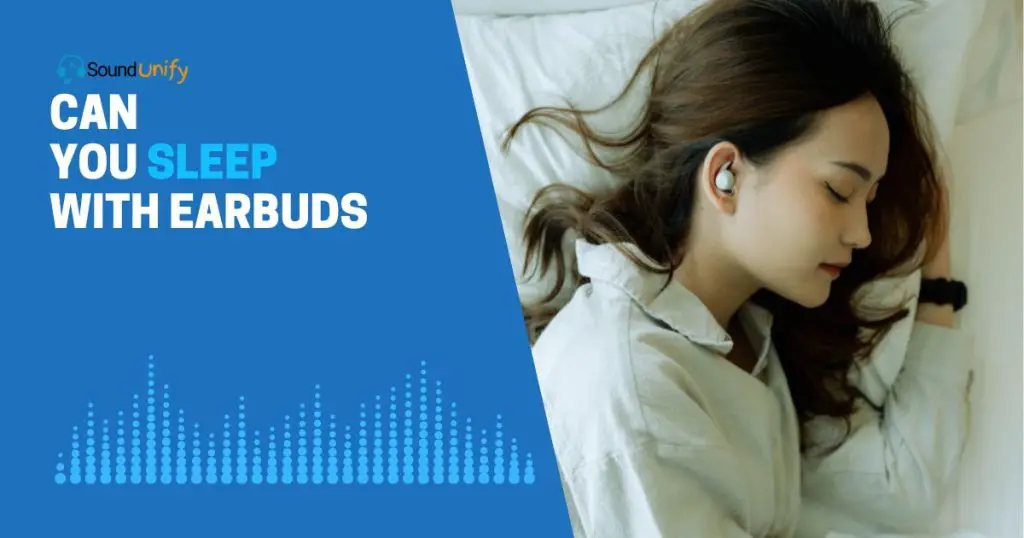
Why People Choose to Sleep with Headphones or Earbuds?
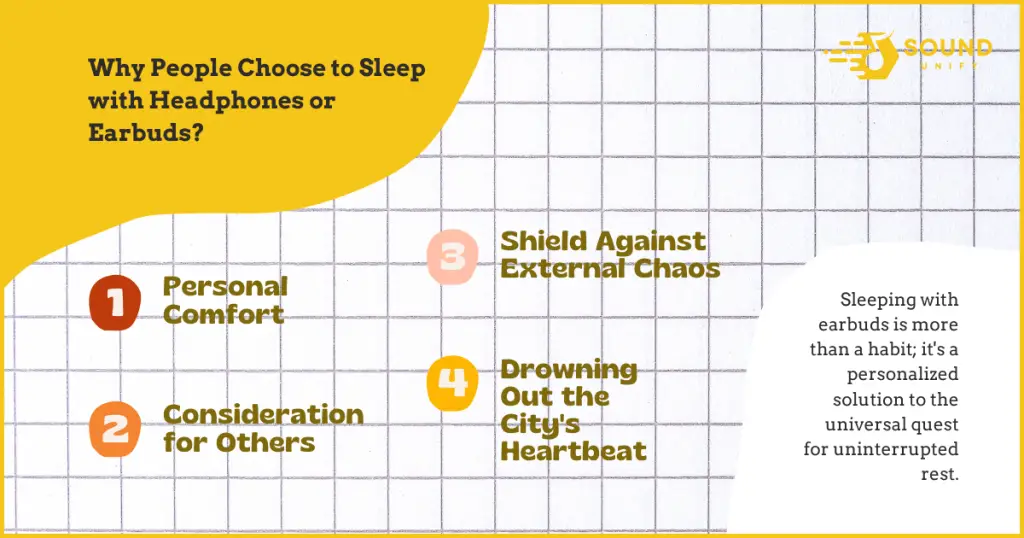
In the quiet of the night, our quest for personal relaxation takes precedence. For many, the gentle lull of music or the rhythmic pattern of rain is not just a preference but a necessity.
Sleeping with earbuds becomes a gateway to a personal oasis where the only sound is the one you choose. Whether it’s a playlist of soft acoustic melodies or the ambient hum of white noise, these sounds wrap around us.
But the choice to sleep with earbuds isn’t solely about personal comfort; it’s also about consideration for those around us:
- Personal Comfort: Whether it’s a playlist of soft acoustic melodies or the ambient hum of white noise, these sounds serve as a comforting blanket, guiding us into sleep’s embrace.
- Consideration for Others: The night is a symphony of differing schedules and habits in shared living spaces. Earbuds allow us to continue our nighttime rituals without disturbing others, ensuring our habits don’t infringe on the peaceful slumber of those around us.
- Shield Against External Chaos: The constant buzz of city life, the unexpected chorus of neighborhood dogs, or the familiar yet frustrating snore from the other side of the bed can disrupt our sleep. Earbuds act as a barrier, transforming disruptive noise into a mere memory.
- Drowning Out the City’s Heartbeat or turning a partner’s snoring into a distant sound, earbuds serve as our nightly guardians, ensuring that peace is never out of reach.
Sleeping with earbuds is more than a habit; it’s a personalized solution to the universal quest for uninterrupted rest.
It’s about crafting a sanctuary of sound in a world that seldom whispers, ensuring our journey to dreamland is as serene as the dreams that await.
The Benefits of Sleeping with Earbuds
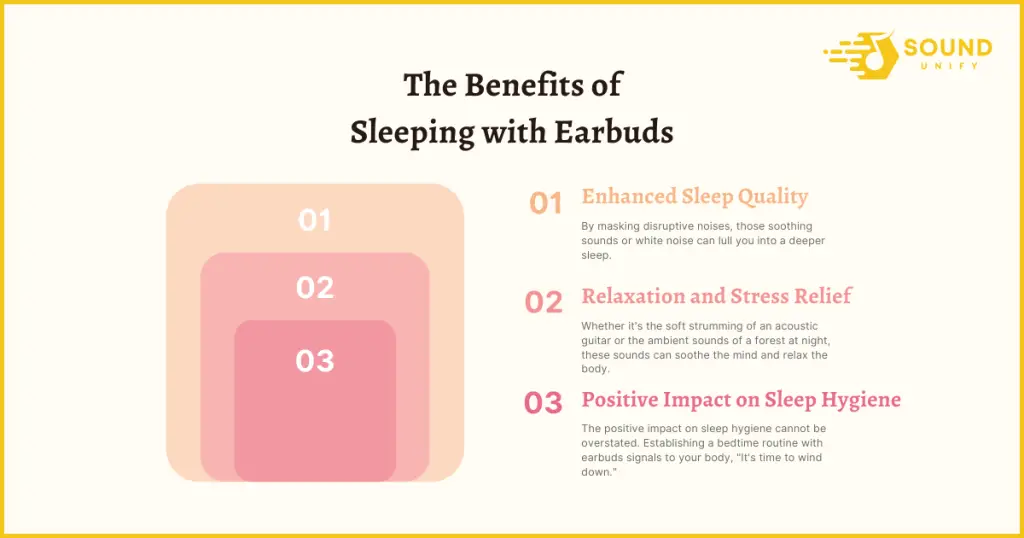
The silence of the night isn’t silent at all. It’s filled with the cacophony of life’s relentless soundtrack for many. Yet, the simple act of sleeping with earbuds can transform this chaos into a harmonious lullaby. Let’s explore the myriad benefits this nightly ritual can offer.
First, enhanced sleep quality isn’t just a dream—it’s a reality for earbud users. By masking disruptive noises, those soothing sounds or white noise can lull you into a deeper sleep. Imagine transforming the roar of traffic into the gentle patter of rain. It’s not just noise replacement; it’s an environment transformation, crafting a cocoon of calm around you.
Next, consider the personal relaxation and stress relief from your chosen sounds. Whether it’s the soft strumming of an acoustic guitar or the ambient sounds of a forest at night, these sounds can soothe the mind and relax the body. It’s like having a personal therapist whispering, “Relax, let go,” as you drift off.
Lastly, the positive impact on sleep hygiene cannot be overstated. Establishing a bedtime routine with earbuds signals to your body, “It’s time to wind down.” This ritual helps in faster sleep onset and in achieving a quality sleep cycle. It’s about creating a sanctuary, a ritual that gently nudges your body and mind towards rest.
Sleeping with earbuds is more than just a method to block out noise; it’s a pathway to tranquility, a journey to a deeper understanding of personal comfort and relaxation. As we embrace this modern lullaby, we find not just rest but a deeper connection to the peace within us.
Potential Risks and How to Mitigate Them
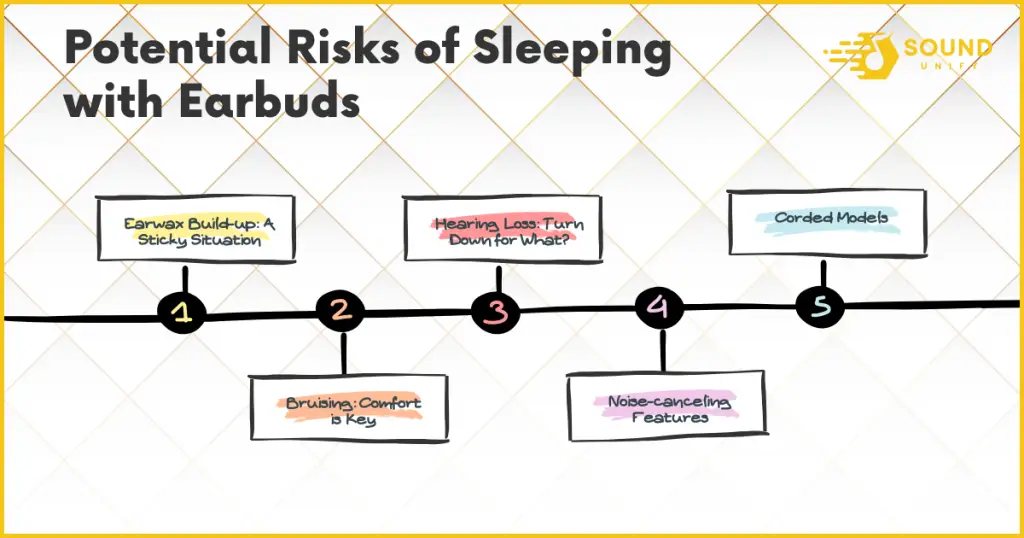
Embracing the serenity of sleeping with earbuds carries its share of caution. Here’s how to sidestep potential pitfalls while preserving the sanctity of your slumber.
- Earwax Build-up: A Sticky Situation. The warmth and consistent use of earbuds can promote ear wax accumulation. To clean ears safely, ditch the cotton swabs; they can push wax deeper. Opt for over-the-counter ear drops or a damp cloth for external cleaning. Regular check-ups with a healthcare provider can ensure your ears remain clear and healthy.
- Bruising: Comfort is Key. Long nights with the wrong earbuds can leave your ears sore. Choosing comfortable earbuds designed for sleep can prevent this discomfort. Look for models with soft, pliable materials that conform to your ear’s shape, ensuring a gentle fit that won’t press hard against your skin.
- Hearing Loss: Turn Down for What? Listening to loud music through earbuds can damage your hearing over time. Keeping the volume low protects your ears. A good rule of thumb: if someone next to you can hear your music, it’s too loud. Opt for settings or apps that limit volume levels to safeguard your hearing health.
- Noise-canceling Features: Hear the Unheard. While blocking out the world sounds appealing, avoiding noise-canceling features at night is wise. In case of emergencies, being able to hear alarms or calls for help is crucial. Let’s not trade safety for silence.
- Corded Models: A Tangled Web. The inconvenience of waking up wrapped in cords, or worse, the risk of strangulation, makes wireless earbuds a safer choice. They offer freedom of movement and eliminate the hazards posed by cords.
By addressing these risks with thoughtful solutions, sleeping with earbuds can remain peaceful. It’s about balancing blissful silence and mindful safety, ensuring our journey to dreamland is serene and secure.
Top Tips for Sleeping Safely with Earbuds
Transforming the night with melodies or the soothing hum of white noise comes with the responsibility of safeguarding your health. Here are the tips for sleeping safely with earbuds, ensuring every journey to dreamland is pleasant.
1. Perfect Your Sleeping Position: Not all positions are equal regarding earbud comfort. Side sleepers, beware: the wrong angle can turn your dreamy playlist into a literal pain in the ear. Consider sleeping on your back or using a soft, supportive pillow to alleviate pressure on your ears, ensuring a snug and comfortable fit throughout the night.
2. Choose Your Gear Wisely: Not all earbuds are meant for the land of Nod. Invest in earbuds designed for sleep, crafted to fit the unique contours of your ear with comfort in mind. Alternatively, explore the realm of special pillows with built-in speakers, offering a seamless blend of comfort and sound without the intrusiveness of traditional earbuds.
3. Mind the Volume: Protecting your hearing is paramount. Adhere to the 60/60 rule: keep your volume below 60% and limit listening to under 60 minutes before sleep. Consider earbuds with built-in volume limits or use a decibel meter app to monitor exposure for a more precise approach. Remember, a gentle lullaby should soothe, not startle.
4. Stay Alert with Smart Alarms: Fearing you’ll miss your alarm is a common concern. Solve this by pairing your earbuds with a smartwatch or a device that offers vibration alarms. These wearable gadgets ensure you wake up on time, gently nudging you awake without the jarring blare of a traditional alarm, making sure you’re punctual to your morning routine.
By adhering to these simple yet effective tips, sleeping with earbuds can remain a safe, comfortable, and enjoyable part of your nightly ritual. Let’s listen to music, and the dreams flow, knowing you’ve taken the proper steps to protect your well-being in the silent symphony of the night.
Choosing the Right Earbuds for Sleeping
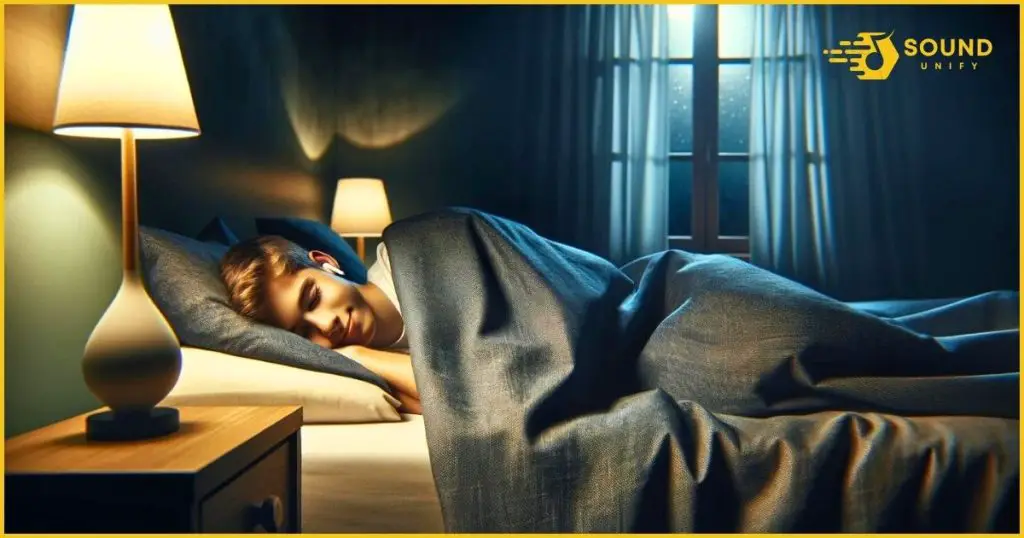
Venturing into the world of nocturnal melodies requires the right companion. Not all earbuds are created equal, especially when the night calls for comfort and serenity.
Here’s how to choose the fitting earbuds for sleeping, ensuring your nighttime soundtrack is as sweet as your dreams.
1. Critical Features for Sleep-Specific Earbuds:
- Comfort is paramount. Look for earbuds with soft, flexible tips that conform to your ear’s shape, minimizing pressure.
- Size matters. Opt for smaller designs that don’t protrude, ensuring they stay put even as you toss and turn.
- Battery life. Choose models with extended battery life or those that offer a wired option to avoid mid-sleep interruptions.
- Sound quality. While you might not need concert-level acoustics, clear and consistent sound can enhance the sleep experience.
- Safety features like volume limits can protect your hearing throughout the night.
2. Recommended Brands and Models:
While specific model recommendations can evolve with technology, brands like Bose Sleepbuds II have garnered acclaim for their comfort and noise-masking capabilities, designed explicitly for sleep.
Other brands worth exploring include Sony and Jabra, known for their audio technology and comfort innovation.
Always check for the latest reviews and models, as technological advancements continuously improve the sleep experience.
3. The Future of Sleep Sound Technology:
The frontier of sleep sound technology is ever-expanding. Beyond traditional earbuds, we’re seeing the rise of intelligent pillows and bedside devices.
That adapts to your sleep phases, playing soothing sounds or gently waking you at the optimal moment.
There’s also growing interest in biofeedback earbuds, which adjust the audio environment based on your heart rate and sleep stage.
The future promises more personalized and integrated solutions, making falling asleep a tailored experience.
How Do Improve Sleep Hygiene With or Without Earbuds?
Achieving a night of restful sleep transcends the use of technology; it’s rooted in the rituals we set and the environment we cultivate. Here’s how to elevate your sleep hygiene, with or without earbuds, nurturing a sanctuary for slumber.
1. Establish a Consistent Bedtime Routine:
- Predictability is soothing to the brain. Aim to go to bed and wake up simultaneously every day, even on weekends.
- Wind down with intention. Dim the lights and engage in calming activities like reading or a warm bath to signal your body it’s time to rest.
2. Explore Natural Sleep Aids and Relaxation Techniques:
- Herbal allies. Chamomile tea, valerian root, and lavender are time-honored relaxants that can ease you into sleep.
- Mindfulness and meditation can reduce bedtime anxiety and quieten a busy mind, preparing you for sleep.
- Breathing exercises, such as the 4-7-8 technique, promote relaxation and can be a powerful tool in your pre-sleep routine.
3. Prioritize Emotional and Physical Well-Being:
- Emotional balance is critical to good sleep. Addressing stress and anxiety through therapy, journaling, or mindfulness can alleviate sleep disturbances.
- Physical activity during the day promotes tiredness at bedtime. However, avoid vigorous exercise close to bedtime as it can energize rather than relax you.
- Comfortable sleeping environment. Ensure your bedroom is calm, dark, and quiet. Consider blackout curtains, eye masks, or white noise machines (or a gentle fan) to create an ideal sleep environment.
With Earbuds: If earbuds are part of your routine, integrate them into these practices thoughtfully. Choose calming sounds or guided meditations that complement your wind-down routine, and ensure your earbuds are comfortable for long-term wear.
Without Earbuds: For those preferring silence, ensure your sleep environment supports this preference. Soundproofing your space or using soft earplugs can help maintain a quiet sleep environment.
Improving sleep hygiene is a holistic process that involves tuning into your body’s needs and creating a conducive environment for rest. Whether you incorporate technology like earbuds or not, the essence lies in consistency, mindfulness, and creating a bedtime ritual that signals to your body it’s time to recharge. By prioritizing your emotional and physical well-being, you pave the way for a restful night and, consequently, a more vibrant life.
Alternatives to Sleeping with Earbuds
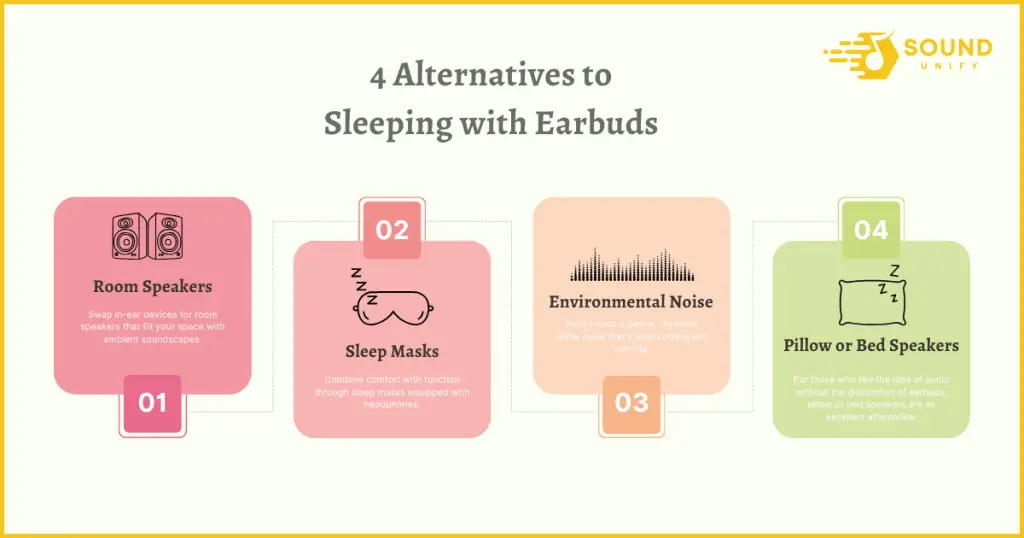
There are numerous alternatives to sleeping with earbuds that can offer similar benefits. Here’s a look at the ones you’ve listed, along with some insights:
1. Room Speakers or White Noise Machines
Swap in-ear devices for room speakers that fill your space with ambient soundscapes.
Or, a white noise machine can become your sleep companion, offering a consistent audio backdrop that masks external disturbances.
These options provide a less intrusive way to achieve a serene environment, perfect for those who prefer an open-ear sleep experience.
2. Sleep Masks with Built-in Headphones
Combine comfort with function through sleep masks equipped with headphones. These innovative gadgets block out unwanted light and deliver your favorite sounds directly, minus the earbud discomfort. It’s a two-in-one solution that encourages both sound sleep and auditory bliss.
3. Environmental Noise Solutions
Sometimes, the most straightforward methods are the most effective. Fans create a gentle, rhythmic white noise that’s both cooling and calming.
Similarly, cracking a window can invite a natural symphony of sounds to lull you to sleep, from the rustling of leaves to the distant murmur of the city. These natural solutions offer a breathable, open atmosphere conducive to rest.
4. Pillow or Bed Speakers
For those who like the idea of audio without the discomfort of earbuds, pillow or bed speakers are an excellent alternative. These devices are designed to be placed under your pillow or mattress.
One such product is the Sangean PS-300 Pillow Speaker. It allows you to enjoy your audio content without disturbing anyone else in the bed and without any ear discomfort.
FAQs
What are the advantages of sleeping with headphones?
Sleeping with headphones can help you fall asleep faster by listening to relaxing music or white noise. It can also drown out external noise and reduce the risk of disturbing your partner.
Is it bad to sleep with earbuds?
Sleeping with earbuds can have some risks. It may pressure your ears and lead to discomfort or ear wax buildup. It is important to use them cautiously and take breaks from wearing them.
Can earbuds help you fall asleep?
Yes, earbuds can help you sleep by listening to relaxing music or calming sounds. They can create a soothing atmosphere and block out distracting noises.
Is it better to wear headphones or earbuds to sleep without snoring?
Both headphones and earbuds can be used to help reduce snoring during sleep. Using noise-canceling headphones or earbuds that fit comfortably in your ears and help block out snoring sounds is recommended.
Is it safe to sleep with earbuds?
Yes, but there are potential risks, such as ear infections, skin irritation, and strangulation from cords. It’s essential to use them safely and consider earbuds designed for sleep.
Can sleeping with earbuds cause hearing damage?
Yes, playing at high volumes for prolonged periods can lead to hearing damage or loss. Always keep the volume at a safe level.
Final Thoughts
Are you sleeping with earbuds? It’s a double-edged sword. The pros: relaxation, noise blockage, potential sleep aids. The cons? Ear health risks, hearing damage possibilities, and those pesky cords.
For me, caution is key. Weighing benefits against risks, picking the right earbud type, and always staying mindful of volume make the difference. Remember, ears need care too. Safety first!
James Dimento is a Chief-in-Editor of SoundUnify. He is a headphone enthusiast and creative writer passionate about audio technology. He has three years of experience writing about headphones and sound quality and is responsible for creating reviews and taking care of all administration.
